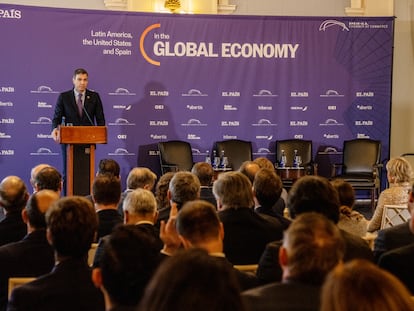Pedro Azagra: ‘The energy transition is unstoppable’
The CEO of Avangrid – the American subsidiary of Spain’s Iberdrola energy giant – feels that the market is robust for renewables
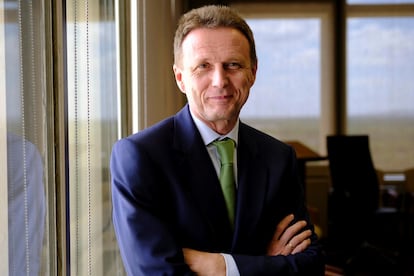

Pedro Azagra has been Avangrid’s CEO since June. While he’s new to the position, he knows the company well: he’s been on the board of directors of the Spanish parent company, energy giant Iberdrola – which controls 81.5% of Avangrid – for many years.
In his first interview since taking over, he highlights how Avangrid – based in Orange, Connecticut – is firmly committed to the transition to renewable energy. He considers this shift “unstoppable.”
“We’re very proud to be part of the energy transition in the United States. Of course, there are people who make a lot of money from [fossil fuels] and are trying to delay the transition, but it doesn’t matter. We’re going to continue moving forward: there’s no turning back. We need the support of politicians in granting permits and ensuring a stable and predictable framework. The whole world needs this,” explains Azagra.
Azagra spoke to EL PAÍS in the New York Stock Exchange building, where, last week, he presented the company’s plans to analysts and investors. The CEO emphasized that the wind is blowing in the direction of renewables with the US Congress passing the Infrastructure Law and the Inflation Reduction Act.
“These laws are going to generate a wave of investment in renewables. When you have financing of $350 or 360 billion and they allow you to sell tax credits on the market, that will boost investments, which were already very strong. We have a 10-year-long framework that gives us a lot of peace of mind. Even during the presidency of Donald Trump, we didn’t stop developing renewables in the United States. We’re going in the right direction. Do we want to go faster? Yes. Do we still have our opponents, like the gas companies? Yes, we’ve always had opponents, but we’re still on track.”
In Maine, for example – where Avangrid is promoting a line to transport hydroelectric power from Canada to Massachusetts – another power company has opposed the project because it has gas interests in that area. “It’s a [natural] competitive reaction,” he shrugs.
Azagra explains that some banks are ceasing the financing of companies that own coal plants and do not have credible plans for closure. Shareholders are increasingly demanding ESG (environmental, social and corporate) values.
“In the United States, the change that has occurred in renewables is dramatic. Coal is practically becoming history; a new plant has not been built in almost a decade and closures are accelerating. That was unthinkable seven or eight years ago, unthinkable,” Azagra explains.
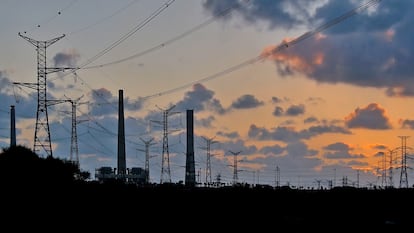
When asked how regulatory changes have affected Avangrid, Azagra replies that the impact has been positive. “There are a series of measures now in place that we think will increase our earnings by at least $50 million annually. Then, there’s the impact on tax returns, which we also believe will be positive. The IRS takes time to analyze all the factors and it will also be necessary to look at everything on a project-by-project basis, but what has already been approved looks good.”
The bulk of Avangrid’s investment for the coming years will focus on transmission and distribution networks, rather than on renewable energy generation – but this will still contribute to the green transition.
“Investment in networks goes hand-in-hand with the deployment of renewables. Generation, transport and distribution must go together. On the one hand, some networks are already 60, 80 or 100 years old and need to be updated; on the other hand, consumption is rising in places where green energy generation isn’t available. We’ll be investing more than $14.6 billion by 2025… it’s almost like setting up a new network the size of the one we already had in place.”
In his presentation to analysts and investors, Azagra brought up the possibility of selling about $2 billion worth of shares. “I’ve been part of this company [Iberdola] for 20 years… we want to do so many things and we don’t always have the financial capacity for everything we have on the table. We’re always looking for partners to participate in our projects.”
Recently, Iberdrola announced an agreement with Energy Infrastructure Partners (EIP) for the sale of 49% of its Wikinger Offshore Windfarm – in German waters of the Baltic Sea — for €700 million ($668 million). In the United States, it has a 50% stake with Copenhagen Infrastructure Partners (CIP) in the 800-megawatt (MW) Vineyard Wind 1 Offshore Wind Farm, 15 miles off the coast of Massachusetts.
The CEO of Iberdrola’s US subsidiary points out where investors can go: “We already have a partner in Vineyard Wind 1, but we can incorporate partners in other offshore wind projects. In solar energy, attractive prices are being paid right now, so we can bring in partners. The money we raise [from the offering] will all be reinvested.” Avangrid currently owns 100% of Commonwealth Wind (1,200 MW in Massachusetts), Park City Wind (804 MW in Connecticut) and Kitty Hawk Wind (2,500 MW off the coast of North Carolina).
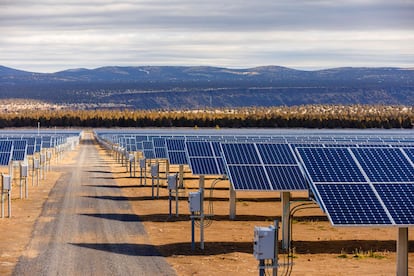
Two of Avangrid’s largest projects are now paralyzed and pending court decisions. In Maine, the company recently won a major legal victory, with the state Supreme Court overturning a referendum opposing the project if the company can show that it has already broken ground.
“We can show that we have already invested $500 million,” Azagra replied when asked about this ruling. In any case, the project is also awaiting another decision from the state Supreme Court regarding a lease of the land through which the company’s hydroelectric power line passes through.
Another project pending the approval of the courts is the purchase of PNM Resources – a New Mexico-based company, which accounts for $6.5 billion of the investments planned by Avangrid. Regulators from Texas greenlighted the acquisition… but those from New Mexico rejected it, as they didn’t consider it to be in the best interests of energy consumers.
Azagra argues that “in any other state, [the purchase] would have been approved. We don’t agree with the arguments that were made… they have nothing to do with a merger case. We think that the law in New Mexico is not being complied with, so we have resorted to the Supreme Court. We are waiting for our hearing – which we hope will be soon – and a final decision from the court. Alternatively, the [regulatory] commission changes on January 1 and we can see what the alternatives are.”
Avangrid is not considering restarting the legal procedure, but depending on what the court rules, Azagra hopes that it may be possible to renegotiate or try to reach an agreement.
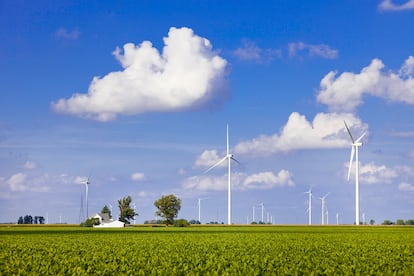
Avangrid currently has a market value of $17.5 billion. Its main shareholder, Iberdrola, puts up 81.5% of the capital. “We are proud to be part of the Iberdrola group… even though we are a listed company and are grateful for our many minority shareholders, we benefit tremendously from everything that Iberdrola offers us,” Azagra says.
The CEO sees the coming years with optimism. “We have a powerful team, very committed, with the desire to take on the future. We have to have zero failures in regulatory issues, zero failures in operations. Offshore projects need to be profitable – they’re doing very well so far. Now, there are supply problems, with increases in the price of steel and raw materials, so this slows us down a little. We want to help the energy transition, but we have to do it without losing money.”
“We will continue to be the first to do certain things... we also need to deliver, quarter after quarter, year after year. In the meantime, we’ll keep looking for new opportunities.”
Tu suscripción se está usando en otro dispositivo
¿Quieres añadir otro usuario a tu suscripción?
Si continúas leyendo en este dispositivo, no se podrá leer en el otro.
FlechaTu suscripción se está usando en otro dispositivo y solo puedes acceder a EL PAÍS desde un dispositivo a la vez.
Si quieres compartir tu cuenta, cambia tu suscripción a la modalidad Premium, así podrás añadir otro usuario. Cada uno accederá con su propia cuenta de email, lo que os permitirá personalizar vuestra experiencia en EL PAÍS.
¿Tienes una suscripción de empresa? Accede aquí para contratar más cuentas.
En el caso de no saber quién está usando tu cuenta, te recomendamos cambiar tu contraseña aquí.
Si decides continuar compartiendo tu cuenta, este mensaje se mostrará en tu dispositivo y en el de la otra persona que está usando tu cuenta de forma indefinida, afectando a tu experiencia de lectura. Puedes consultar aquí los términos y condiciones de la suscripción digital.
More information
Archived In
Últimas noticias
Welcome to the post-religion era: The idea of Christianity as the absolute truth has become obsolete
‘I thought you would like it’: The risky sexual practice popularized by TV shows and TikTok
The digitalization of tourism: ‘They promise experiences and gave us the worst possible one’
Mexican peso defies uncertainty with forecasts of a new period of stability in 2026
Most viewed
- Sinaloa Cartel war is taking its toll on Los Chapitos
- Oona Chaplin: ‘I told James Cameron that I was living in a treehouse and starting a permaculture project with a friend’
- Reinhard Genzel, Nobel laureate in physics: ‘One-minute videos will never give you the truth’
- Why the price of coffee has skyrocketed: from Brazilian plantations to specialty coffee houses
- Silver prices are going crazy: This is what’s fueling the rally

